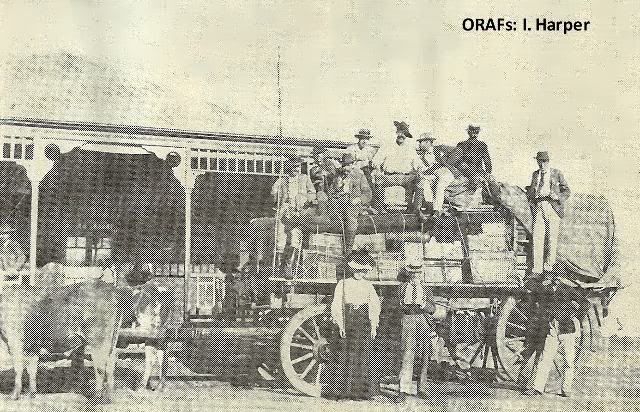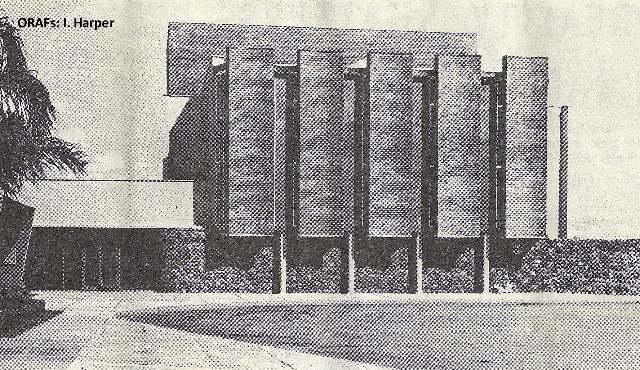Rhodesian Navy Puts to Sea
A party of Rhodesian Sea Cadets left last week-end for a training voyage in the cruiser Euryalus, sailing from Durban. Here is an account of life in the Sea Cadets when they are not at sea, as told by one of them, a young Salisbury man.

Sea Cadets packing in Salisbury last week for their training trip in the cruiser Euryalus.
Left to right: Petty officer D. L,Woods, Able seaman C. R. Morris, Leading seaman G, F.Strong,
Able seaman E. H. Armitage, Abie seaman R. J.Stevens and the stores clerk, Leading writer GL E. C. Collins.
Oh yes, Rhodesia has a navy - or perhaps it would be better to say the Colony has a flourishing Sea Cadet unit in which are the only active representatives of the Senior Service in this part of the world.
The First Division Rhodesia Sea Cadet Corps prides itself on carrying out a training programme in seamanship which is equal to that of the Royal Navy. Indeed, when Capt. R. Selby, R.N., captain of Her Majesty's Dockyards at Simonstown and during the war captain of Mashonaland's adopted ship, H.M.S. Mashona - saw the paper set for the able seaman's examination which the Unit held on May 13, 1952, he told the ratings that it was "well up to the Royal Navy standard." And 20 Rhodesian lads, many of whom had never seen the sea, passed the stiff examination with flying colours.
DARTMOUTH . . .
Who are the ratings of the First Division Rhodesia Sea Cadets Corps? Some are employed, some go to school; some are Territorials seconded to the Sea Cadets for further instruction; some are doing their school cadet training in the unit; some have definite ambitions to go to the Dartmouth Naval College or to the South Africa's nautical college - "General Botha". Others, older, are learning seamanship in case . There are 60 ratings, commanded by Lieutenant S. Burn, R.N.V.R. who re-organised the unit in 1950. The military aspect is not over looked; Staff Corps instructors take care of that. Square bashing and rifle drill are all part of the training for these future Rhodesian sailors.
THE CRUISE
The Sea Cadets become the envy of many Rhodesian youths when their annual training cruise comes along. They don't go to Inkomo Camp but to the South Atlantic for their training. Three or four weeks are spent annually by ten ratings aboard the flagship of the South Atlantic Fleet. In 1950 it was H.M.S. Nigeria and in 1951 it was H.M.S. Bermuda. Don't misunderstand that word "cruise". Their training is no pleasure trip - they literally work their passage. But these ratings return to the unit in a better position to understand the theoretical instructions which they receive and are more independent and responsible than before they went.
BERMUDA
In the 1951 cruise aboard H.M.S. Bermuda it seems that Vice-Admiral (as he then was) Sir Herbert Packer took particular notice of the Rhodesian Sea Cadets who were aboard his flagship. For when he paid a goodwill visit to the Colony in 1951, he spoke to the Sea Cadets and told them of his real pleasure at the manner in which they had carried out their assorted duties aboard his ship. He was sufficiently impressed to grant the ratings who went on this Cruise permission to wear the cap tally of H.M.S. Bermuda in the future - the ratings had served in his ship and proved themselves worth representatives of that fine cruiser. On various occasions when a nautical air is required at any function the Sea Cadets assist.
THE ADMIRAL
They formed a guard of honour for Admiral Sir Herbert Packer when he opened the last agricultural show in Salisbury. They again presented a token guard of honour when the Governor, Major-General Sir John Kennedy, opened Lake Mcllwaine - he afterwards expressed his appreciation in writing. The practical side of the unit's activities has in the past been carried on at Mazoe Dam, where picnickers would see the white-capped ratings rowing or sailing and, seemingly, never satisfied with the strength of the breeze. Recently their activities have been transferred to Lake Mcllwaine, where a "base" has been obtained through the Defence Department.
THE FLEET
And what sort of fleet has Rhodesia's navy? There is a 14ft. dinghy, a 27ft. Admiralty whaler and three sailing yachts. Now the unit wants another whaler, more yachts and a motor launch. Last month London saw some of the Rhodesian Sea Cadets in the Coronation celebrations. So even in Rhodesia, so far from the sea, it is still possible to join the Navy and see the world.
End of Article
Extracted by my daughter, Denise, from the newspaper "The Sunday Mail Magazine Section" , July 12, 1953) Thanks DeniseNo financial gain is intended from producing these memories.
Apologies for the low quality photograph.Thanks to:-
My son, Paul Norris, for the ISP sponsorship.
Paul Mroz for the image hosting sponsorship.
Robb Ellis for his assistance.
Should you wish to contact Eddy Norris please mail me on orafs11@gmail.com
FURTHER INFORMATION RECEIVED
Tony Viegas Writes:-
I read with interest the Article in the recent Newsletter about the "Rhodesian Navy".
Attached are 2 photographs of me in Summer and Winter Uniform taken in 1967/68, at the tender age of 13 or 14, when I was a Sea Scout at HMS Matabele.
The Sea Scouts gathered on a Friday evening at Brady Barracks in Bulawayo. We were taught semaphore signalling, Morse code, the different types of rope knots, and many other Naval matters.
The Sea Scouts were part of the annual Armistice Day Parades.
End
Further Information received from Craig Fourie
Fished out this old cap i found in a Bulawayo antique store in 1992
End
Thanks to Craig for sharing this information with ORAFs.
Source. Rhodesia Railways Magazine dated February 1974 which was made available
to ORAFs by Craig Fourie. Thanks Craig.
End of Article
Extracted by my daughter, Denise, from the newspaper "The Sunday Mail Magazine Section" , July 12, 1953) Thanks DeniseNo financial gain is intended from producing these memories.
Apologies for the low quality photograph.Thanks to:-
My son, Paul Norris, for the ISP sponsorship.
Paul Mroz for the image hosting sponsorship.
Robb Ellis for his assistance.
Should you wish to contact Eddy Norris please mail me on orafs11@gmail.com
FURTHER INFORMATION RECEIVED
Tony Viegas Writes:-
I read with interest the Article in the recent Newsletter about the "Rhodesian Navy".
Attached are 2 photographs of me in Summer and Winter Uniform taken in 1967/68, at the tender age of 13 or 14, when I was a Sea Scout at HMS Matabele.
The Sea Scouts gathered on a Friday evening at Brady Barracks in Bulawayo. We were taught semaphore signalling, Morse code, the different types of rope knots, and many other Naval matters.
The Sea Scouts were part of the annual Armistice Day Parades.
End
Further Information received from Craig Fourie
Fished out this old cap i found in a Bulawayo antique store in 1992
End
Thanks to Craig for sharing this information with ORAFs.
Rhodesian Navy - 1974A contingent of Rhodesian sea cadets recently visited Pretoria on a
promotion course. All four are sons of railway men and from left to
right they are:—
 |
A. Soule, 15 years; A. de Barros, 15 years;
E. van Staden, 16 years and J. Crilley, 13 years.
|
Labels: Abie seaman R. J.Stevens and the stores clerk, Able seaman C. R. Morris, Able seaman E. H. Armitage, F.Strong, Leading seaman G, Leading writer GL E. C. Collins., Navy, Petty officer D. L, Woods





